Echinacea is a genus of about ten species of herbs more popularly called coneflowers.
These flowering plants belong to the aster, composite, daisy, or sunflower family Asteraceae or Compositae. They are native to North America.
Species belonging to this genus Echinacea are only found in the eastern and central regions of North America.
Typically, they have large, flamboyant, and composite flowers that bloom in the summer.
The perennial wildflowers grow in moist, dry grassy plains and open wooded areas.
Their different parts are used for several purposes and species are also grown for many diverse reasons.
While some of them are planted in gardens for their flowers which attract a lot of pollinators, some are made into products and sold as dietary supplements.
Their flowers are usually rose-colored and rarely yellow or white.
Table of Contents
If you intend to grow any of the species of Echinacea, bear in mind that they are very friendly and have few enemies.
They go with almost any garden plant that they may be planted with. They are generally good companion plants.
A good companion plant is a crop that can grow comfortably with another one, help with its growth, and encourage better harvest.
It could also be a plant that the plant in question can provide benefits to.
The goal is to provide plants with a friendly and healthy environment for optimal growth.
If they are not gaining or benefiting their neighbors, the living conditions must at least be very conducive for both or all parties.
The companions may help each other by repelling harmful pests, inviting or attracting useful insects for pollination and pest control, renewing soil nutrients, serving as ground cover, or providing shade.
A plant may be considered a suitable companion for another if they: can grow together without one thriving while the other is dying, have similar growth needs, and do not compete with each other for space or soil nutrients.
Though most flowers, fruit trees, herbs, and vegetables in the brassica and nightshade families are generally compatible with these species, twenty-five (25) good companion plants for Echinacea are listed and explained below.
Species in the genus Echinacea are largely compatible with many other plants but to choose companions for them, it is important to consider if the two plants enjoy the same or at least similar growing conditions.
Echinacea plants like growing in moist, well-draining soil with neutral pH levels.
They do not like a lot of moisture and can easily be overwatered. In addition, they can grow in both sunny and shaded environments.
It would also be helpful to grow them around other flowering plants to aid pollination and attract beneficial insects to the area.
Most herbs and vegetables with similar requirements will appreciate the presence of coneflowers around them.
Good Companion Plants for Echinacea
When planting coneflowers, choosing the best companion plants is crucial for creating a thriving ecosystem. These companions not only enhance the garden’s aesthetic with their flower shapes and colors but also support the echinacea pallida and e. purpurea varieties by improving organic matter in the soil and ensuring good drainage, crucial for the long tap roots of tall plants.
1. Bee Balm

Bergamot, horsemint, or bee balm is a genus of flowering plants, Monarda, in the biological family Lamiaceae which is also known as the mint family.
Plants in this genus are native to and only grow in North America.
Bee balm is a good companion plant for Echinacea plants because they have similar growing needs.
They both thrive whether kept under full sun or partial shade. Bee balms are not as drought resistant but like even moisture.
Bee balm, with its purple echinacea-complementing flowers, acts as an excellent cut flower and great butterfly plant, making it a great companion plant for echinacea companions in butterfly gardens. They help the reproduction of plants by aiding pollination.
Echinacea plants also attract beneficial insects. They can benefit from bee balms’ ability to attract animals and insects that eat pests, for instance, ladybugs.
Echinacea plants can suffer from the damaging infestation of aphids.
Ladybugs and their larvae prey on these aphids. Bee balms attract ladybugs so it helps control the pests.
Deer, rabbits, mildew, and other pests and diseases can be prevented by having bee balms around Echinacea.
2. Black-Eyed Susan
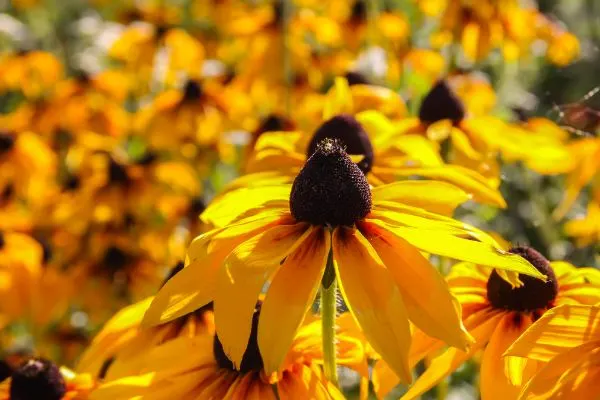
Also called brown betty, English bull’s eye, gloriosa daisy, or yellow daisy, black-eyed Susan is a flowering plant in the daisy family Asteraceae, just like Echinacea plants.
It is a wildflower native to eastern and central North America.
This plant has beautiful flowers which usually have ray florets in the color yellow circled black or brown disk florets in the shape of a cone.
The ray florets may also be brown, orange, or red.
This contrast highlights the statuesque color of purple echinacea, making them outstanding ornamental flowers in wildflower gardens. Black-eyed Susans can pleasantly complement your Echinacea plants when they are placed side by side in the garden.
Moreover, they are comfortable growing together as they both do not require too much moisture for proper growth.
The reproduction of plants is also aided by the pollinating insects and animals that black-eyed Susan attracts.
Some of such include bumblebees, butterflies, chickadees, goldfinches, moths, and sparrows. In addition to attracting beneficial insects and birds to aid pollination, black-eyed Susan also repels deer and rabbits.
3. Blanket Flowers
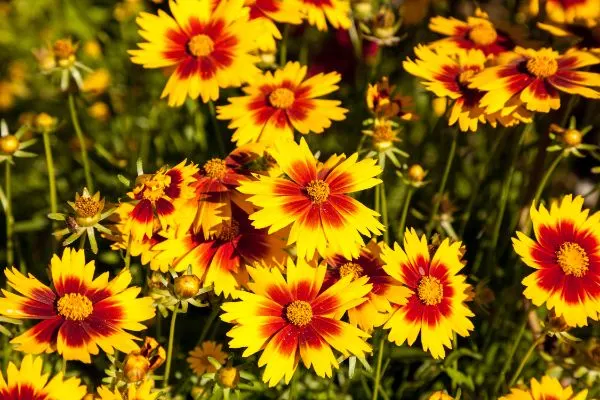
Another genus of wildflowers suitable as companions for Echinacea plants is Gaillardia, commonly known as blanket flowers.
These flowering plants belong to the biological family Asteraceae, native to North and South America.
They have beautiful sunset-colored flowers and cultivars may even be bred simply for ornamental use.
These flowers are usually bicolored and may be any shade of brown, orange, purple, red, white, or yellow.
Like Echinacea, blanket flowers like to grow in moist, well-drained soil. They do not find overwatered soil conducive as it causes several problems for them.
Because they have similar requirements, these plants are compatible.
The flowers of these plants make your garden area more aesthetically appealing, especially to pollinators.
Echinacea plants and blanket flowers can attract pollinators on their own but growing them together attracts even more butterflies.
4. Broccoli
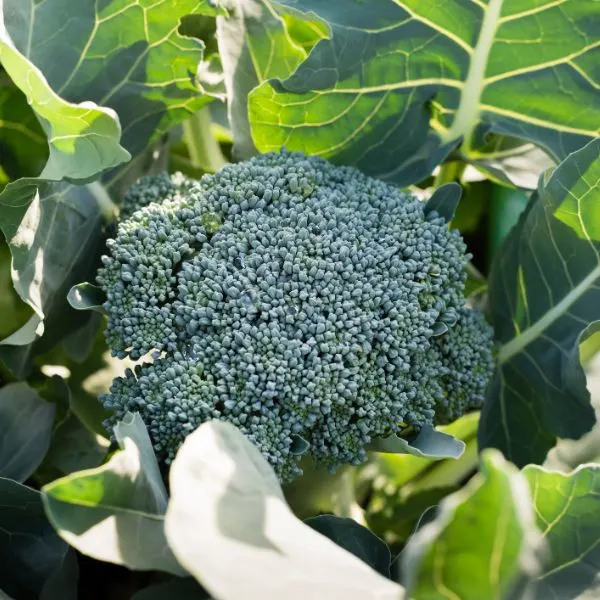
Broccoli is a flowering plant in the family Brassicaceae, the cabbage family.
It has large, partly developed green flowers that make up its head, stalks, and leaves which are the edible parts of the plant, the main reason it is cultivated.
This vegetable is a good companion plant for Echinacea. The reason is large that both are flowering plants that need to be pollinated and attract pollinators.
Cultivating them near each other simply means more pollinators.
A balance can also be achieved with this companionship. As heavy feeders (plants that require more nutrients than most others for their growth), broccoli plants need to be grown with light feeders that do not need as many nutrients.
This will prevent competition between them for both space in the soil and nutrients for growth.
Echinacea is a light feeder. When planting them together, caution should be taken to avoid the infestation of pests.
Aphids are well known for attacking broccoli and other plants in the brassica family. Being that they tend to feed on almost anything, aphids also easily infest and even destroy plants in the genus Echinacea.
5. Brussels Sprouts
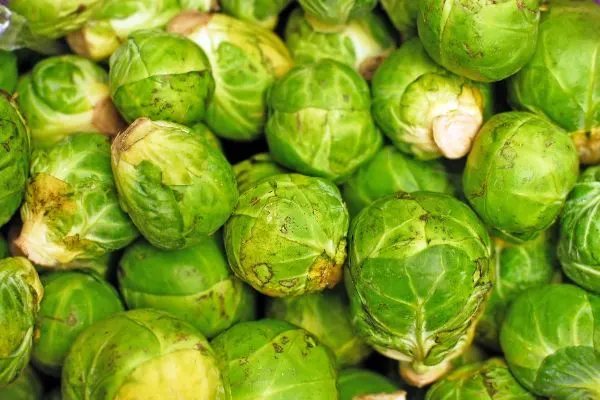
Another brassica that may serve as a good companion for Echinacea is the Brussels sprout.
Brussels sprouts are flowering plants in the cabbage family grown for their edible buds. They are green leafy vegetables resembling very small cabbages.
As flowering plants, both Brussels sprouts and coneflowers will benefit from being planted together.
They attract insects and animals like several kinds of birds to your garden to help with the reproductive process of pollination.
This brassica is also a heavy feeder, requiring more nutrients than most plants.
The presence of Echinacea plants which are light feeders evens out the stress on the soil. It ensures that competition does not occur in that area.
It will be beneficial to add plants that attract pest predators (like ladybugs and parasitoid wasps) or repel common plant pests like aphids to the companionship.
This is because both coneflowers and Brussels sprouts can face aphid infestation.
6. Butterfly Weed

Butterfly weed is a species of milkweed that is native to the east and southwest of North America.
Milkweed is a genus, Asclepias, of perennial herbaceous flowering plants so called because they produce a milky substance called latex.
The flowers of butterfly weed could be orange, red, or yellow. They produce an ample amount of nectar which is an attraction to pollinating insects.
The plant is also given its name because it is very attractive to butterflies specifically.
Butterfly weed is a tall plant that prefers to grow in full, direct sunlight and for this reason, if you want to pair it with a plant in the genus Echinacea, grow them in a site where they will receive adequate amounts of sunlight.
The companionship between these two crops is beneficial as they are both able to attract pollinating insects and animals.
The colorful flowers of butterfly weed make the area that Echinacea’s purple flowers are in more aesthetically pleasing.
Another benefit is that as a hardy perennial, butterfly weed has a deep, sturdy taproot that helps hold its companion upright. Echinacea is complemented by the presence of butterfly weed beside it.
7. Cabbage

Like other brassicas, cabbages grow well beside Echinacea.
Cabbage is a flowering biennial plant mostly grown as a vegetable crop for its edible and tightly packed leaves. These leaves are layered and may be white, red or green.
Both cabbages and species of Echinacea need insects and animals to aid pollination which is their reproductive process.
Bees, butterflies and several other pollinators will be more drawn to each of them when they are grown side by side.
Perhaps the only downside to their relationship is that they are both easily susceptible to attacks from aphids.
To control these pests, plant some other crops that repel aphids or attract their predators in the area as well.
Growing cabbages with Echinacea ensures that the nutrients in the soil are not used up.
Cabbage requires more nutrients than average for its optimal growth but coneflowers do not. This is a beneficial balance.
As much as brassicas do well beside Echinacea, be sure to avoid planting more than one of these types of vegetables in the same area to avoid competition and depletion of the nutrients within the soil.
8. Cardinal Flower
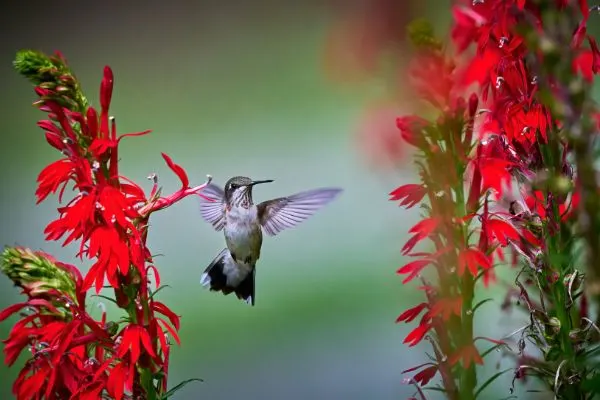
The plant species commonly known as the cardinal flower is a species of flowering plant in Campanulaceae, which is also known as the bellflower family.
It is native to the Americas with long, broad leaves and vibrant red, five-lobed flowers.
Also observed in white and pink colours, the flowers of this plant are conspicuous and showy.
Adding to the aesthetic appeal of your garden, the flowers of both plants can attract bees, butterflies, goldfinches and hummingbirds.
With the presence of livestock and insects to feed on nectar and move seeds, the process of pollination is aided in these plants. Cardinal flowers struggle to grow in areas with dry or barren soils.
They prefer rich soil which is moist to wet.
This requirement is not problematic because although established Echinacea plants are heat and drought-tolerant, they also like to grow in rich, evenly moist, well-draining soil.
Cardinal flowers tend to grow well around plants with blue and purple flowers, Echinacea being one of these with its predominantly purple flowers.
It produces nectar, drawing pollinators to itself and other plants in your garden this way.
9. Catmint
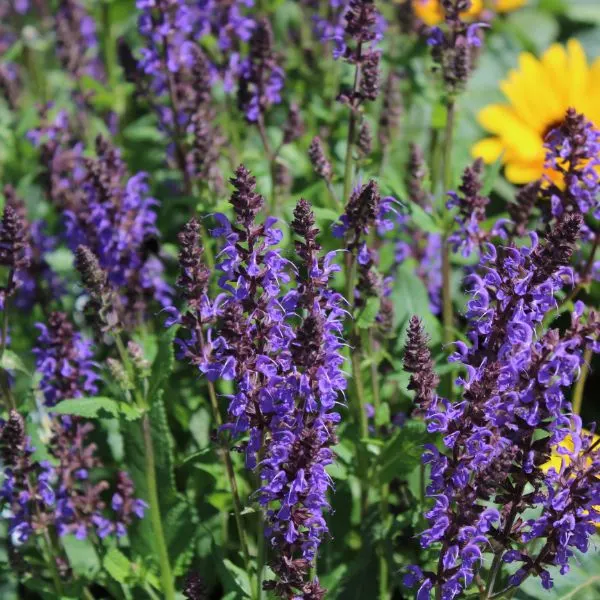
Known also as catnip, catmint is a genus Nepeta of aromatic herbs in the mint family Lamiaceae.
There exist about 250 species of flowering plants in the family. They are native to Africa, Asia, and Europe.
The plants are known as catnip or cat mint because of the euphoric effect that the compound in most species, called nepetalactone, has on house cats.
They have tubular flowers which may be blue, lavender, lilac, pink, or white.
Catmint needs constant moisture until it becomes well-established in the soil. From then on, it is basically drought tolerant and very easy to care for.
It also requires full sunlight to partial shade, just like Echinacea.
With similar care requirements and beautiful flowers which mix very well with those of Echinacea plants, catmint is quite good as a companion plant for Echinacea.
Their flowers can attract even more pollinators to your garden.
In addition, catmint serves as a good pest repellent because of its strong aroma.
It deters pests of coneflowers like aphids and Japanese beetles. For other crops, it can deter cabbage loopers, cucumber beetles, flea beetles, and squash bugs.
10. Cauliflower
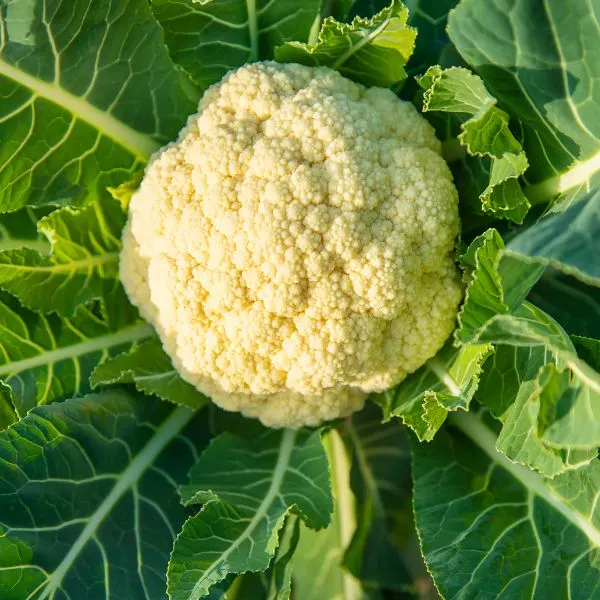
Cauliflower is another flowering plant in the Brassicaceae family, cultivated for its partially developed flowers, referred to as the head or “curd”.
The head is edible and mostly in the colors white, yellow, green, orange, brown, or purple.
Just as other brassicas like broccoli, Brussels sprouts, and cabbages naturally go well with coneflowers in the garden bed, cauliflower also is a good companion for Echinacea.
It aids pest control and serves as ground cover.
Although inconsistently, some brassicas like cauliflower are known to release chemical compounds called biotoxins which may be toxic to some pathogens and pests which live in and spread to other plants through the soil.
The biotoxins control nematodes, fungi, and some weeds. By doing so, they help preserve the health of your coneflowers.
As a ground cover, they also help with the health of the soil by conserving moisture and preventing soil erosion.
Brassicas are also able to scavenge for nutrients, capturing nitrogen in the soil.
Because they are heavy feeders, they need this nutrient. Echinacea is a light feeder which does not need as many nutrients.
This balance and cauliflower’s ability to capture nitrogen from the soil ensure that both plants are healthy and not in some unhealthy competition (which would likely be more disastrous for your coneflowers).
The flowers of both plants can bring pollinators to the area. Only be careful with this pairing because of aphid infestation and the spread of other pests.
You can plant catmint or other crops that help control pests around them.
11. Chamomile

Also spelled camomile, chamomile is a herbaceous flowering plant that belongs to the daisy family Asteraceae.
It has flowers that resemble daisies, with a yellow center made up of tiny flowers (disc florets) and white petals (ray florets).
Chamomile, a medicinal plant with notable medicinal properties, shares similar growth needs with echinacea, thriving in existing conditions without much care. Both plants are fairly drought tolerant after being established, although they love consistent moisture in the earlier stages.
They both grow well in full sun or partial shade.
When planting them together, it would be best to do so in an area where they can receive full exposure to sunlight. This is because chamomile prefers and grows better under direct sunlight than in partial shade.
Because it is an aromatic plant with a strong scent, several plant pests are repelled by it.
Chamomile is another plant that can be grown with both Echinacea and brassica. Its smell masks that of plants beside it and confuses pests.
It has beautiful flowers which attract insects like honeybees, beneficial wasps, and ladybugs that are useful in the garden.
They help spread pollen grains while controlling the infestation of pests like aphids, beetles, mites, thrips, and whiteflies.
12. Chives
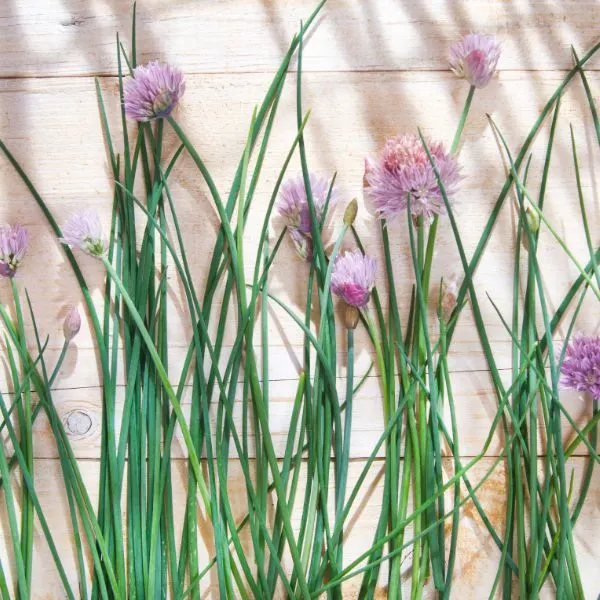
Chives are flowering plants in the genus Allium, to which some other aromatic plants like garlic, onions, and shallots also belong.
They are cultivated for the edible leaves and flowers they produce, which are then used to season food.
They are good companions for coneflowers because they are very effective at controlling pests.
They like full sun and lots of moisture, so consider planting them a few meters away from your Echinacea plants or using physical barriers.
Although chives also thrive in partial sun, plant them in a spot where they can receive full exposure to sunlight. This will be more beneficial to them and is not harmful to the growth and health of Echinacea.
The similarity in growth needs is not the only reason chives and coneflowers should be grown together.
Chives and other alliums contain sulfur, which is the reason for their strong smell which insects are averse to.
Sulfur is also a natural antibacterial compound and fungicide, so chives can control both pests and diseases.
They deter aphids, beetles, mites, deer, and rabbits. Just like other alliums, chives can protect your crops from fungal diseases.
You can plant chives with Echinacea and other companions which cannot ward pests off by themselves.
All flowering plants need pollination for their reproduction. They benefit when other flowering plants are grown beside them.
Chives have stunning purple-pink flowers that attract insects to aid pollination and control pests.
They attract bees, parasitoid wasps, and other predators of common pests of garden crops, including Echinacea (like aphids).
They can also prevent soil erosion with their dense roots that help your soil stay in place.
Using a physical barrier in the soil also ensures that the fast-spreading roots of chives do not dominate the area and become harmful to your coneflowers.
13. Coral Bells
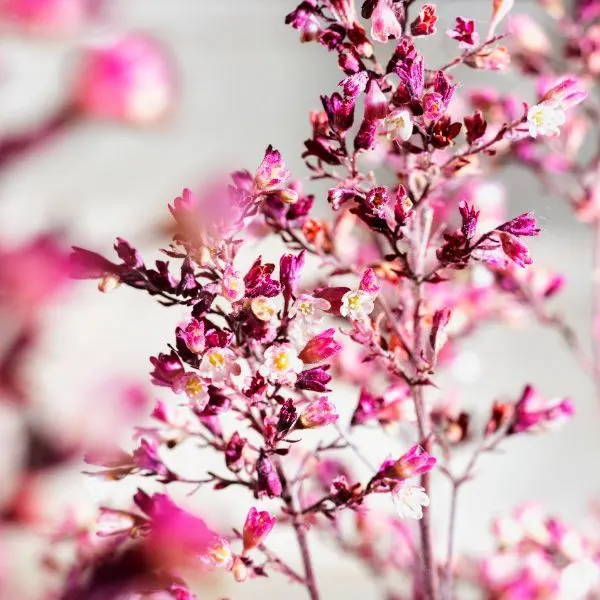
Commonly known as alumroot or coral bells, Heuchera is a genus of flowering plants in the family Saxifragaceae.
These largely evergreen perennials are all native to North America. About 37 species are currently known in this genus.
These plants produce orange, pink, red, or white flowers that are attractive to bees.
Coral bells contain tannins or tannoids, which are sharp or sour bitter-tasting chemical compounds. They are polyphenolic, gotten through plant-based foods.
Because of these tannins, coral bells are bitter and mostly free of pests. They prefer to grow under partial shade, more especially in warmer climates.
Like Echinacea, they love to grow in moist and well-draining neutral or slightly acidic soil.
Coral bells are beneficial to Echinacea because they attract beneficial insects and animals (like hummingbirds), make the garden environment more aesthetic and pleasing to look at, and protect your coneflowers from several harmful pests.
14. Coreopsis
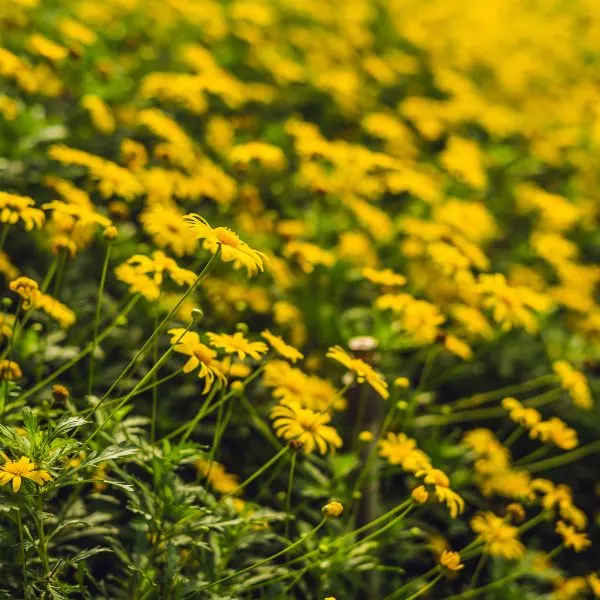
This is a genus of plants also known as calliopsis or tickseed. The species of flowering plants herein belong to the daisy family Asteraceae.
Flowers are most commonly yellow but some are bicolor: red and yellow.
Echinacea and coreopsis will both thrive in the same growing conditions.
They both like slightly and evenly moist soil that drains well. Whether they are under full sun or partial shade, their health and growth will not be negatively affected.
Coreopsis can bring pollinators to your garden.
Having it around is sure to attract several types of bees to the area, like cuckoo bees, leaf cutter bees, long-horned bees, and small carpenter bees. It also attracts butterflies.
Other beneficial insects that prey on your crop’s pests will also come. Some are hoverflies, lacewings, ladybugs, and parasitoid wasps, all of which prey on aphids — one of the most common crop pests that also attack coneflowers.
15. Eggplants
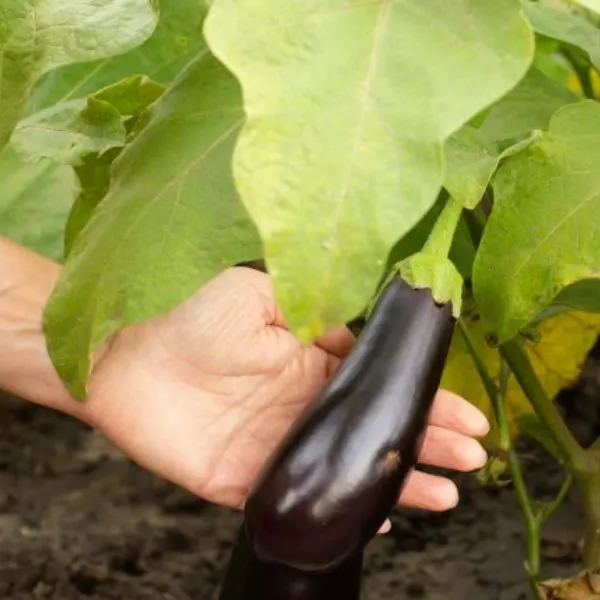
Eggplant, baby marrow, aubergine, courgette, or zucchini is a vining plant in the nightshade family Solanaceae.
It is a flowering herbaceous plant with deep taproots, a heavy feeder, and summer squash.
Summer squashes are herbs grown for their fruits which are then harvested when they still have immature seeds and soft, edible rinds. Heavy feeders are crops that need lots of water and nutrients to grow well.
While eggplants need plenty of moisture and coneflowers do not, the roots of eggplants are deep.
This means that they are able to source their own water from deep in the soil. They prefer full sun so plant both crops in a sunny site.
As flowering plants, both Echinacea and eggplants can benefit each other by attracting pollinators to the area they are planted in.
Eggplants attract bumblebees but do not need these insects for pollination as it is most pollinated by wind.
Aphids, flea beetles, whiteflies, and some other pests attack both coneflowers and eggplants.
This might lead to the spread of pests and heightened attraction to that area. Plant some pest-repellent crops near these two to help curb infestations.
16. Geraniums
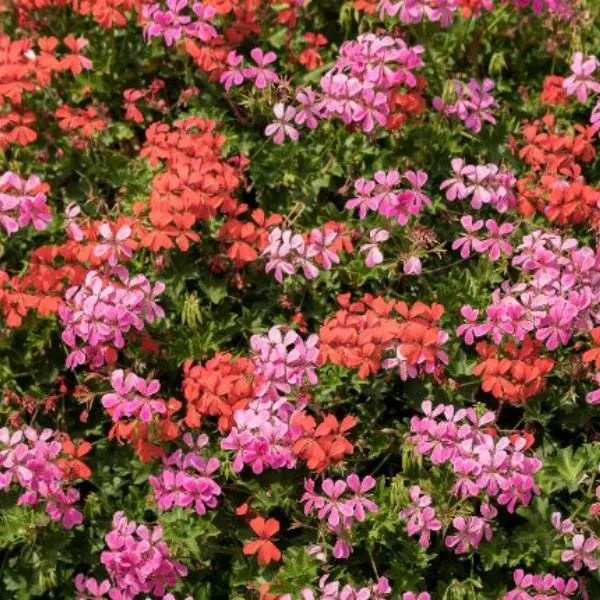
Geraniums or cranesbills are about 422 species of annual, biennial, or perennial flowering plants belonging to the family Geraniaceae.
They have beautiful flowers in a range of colors including blue, pink, purple, and white.
Their moisture needs are not cumbersome. They require constant amounts of water in their earlier days and become drought resistant later on.
They grow comfortably as long as the soil is not soggy or waterlogged.
Be sure you have a sunny spot for your Echinacea if you intend to grow them with geraniums as most species (save one) prefer to grow under direct sunlight.
These two plants are not good companions only because of these similarities.
The flowers of geraniums are attractive to bees, butterflies, and hummingbirds which are pollinators.
Ants, beetles, and flies may also aid this reproductive process. Geraniums not only attract beneficial insects; they repel destructive ones too.
They can be planted among vegetables and other plants that are easily susceptible to attacks from cabbage worms, corn earworms, Japanese beetles, leafhoppers, mosquitoes, and wasps.
Geraniums deter the above pests.
17. Lavender
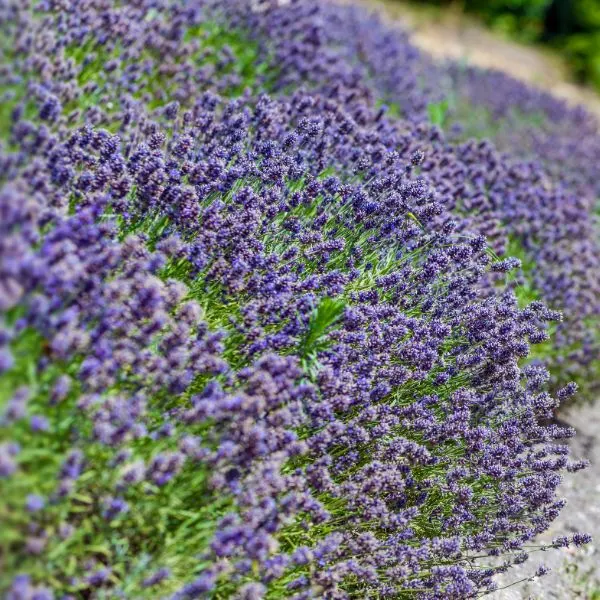
Lavender is a genus of about 47 flowering plants belonging to the mint family Lamiaceae.
These herbaceous plants are grown for food, medicine, and ornamentation. Their flowers are usually blue, lilac, or violet in color.
You would also, although less commonly, find some species with flowers that are blackish-purple or yellowish.
These flowers are very aesthetically pleasing and tend to complement those of your Echinacea and other plants.
Much like Echinacea, lavender needs adequate, consistent, and even watering when it is in its early stages. As the plant matures, it becomes more drought-tolerant and does not need as much moisture.
It also needs full sun, which is direct exposure to sunlight for six to eight hours daily.
Lavender is a good companion plant for Echinacea because it can deter pests with its strong scent while attracting beneficial insects with its beautiful flowers.
The plant is an excellent repellent for fleas, flies, moths, and mosquitoes. They in turn attract butterflies and ladybugs, both of which are beneficial.
Butterflies aid the process of pollination and ladybugs prey on plant pests.
18. Onions
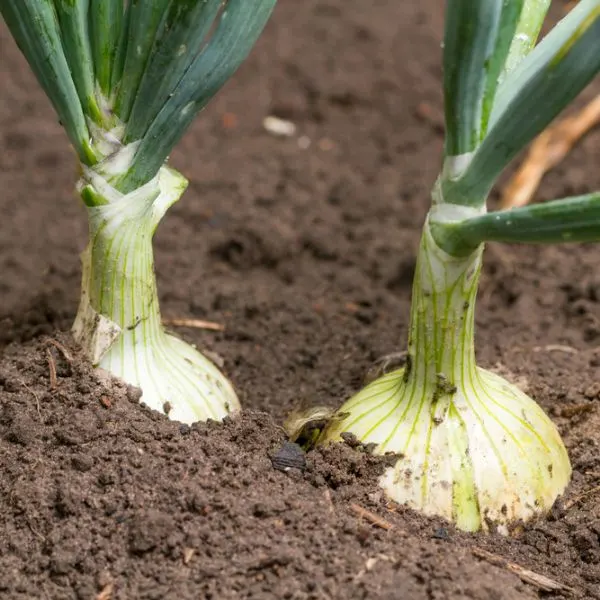
Onions, like chives, are flowering plants in the genus Allium: the most widely cultivated in the genus even.
They are also known as bulb onions or common onions, with bluish-green leaves and a bulb at the base of each plant.
They produce a sharp odor which is likely due to the sulfur that they naturally have within them.
This makes onions good for repelling pests as well as controlling some plant diseases, as the chemical sulfur is a natural antibacterial and fungicide.
Both onions and Echinacea thrive in full sun. However, the onion is a moisture-loving plant that needs a constant water supply for its growth.
For this reason, adequate space should be given between these plants, or physical barriers used.
Onions still provide coneflowers with the benefit of repelling several pests.
They keep aphids, Japanese beetles, rabbits, maggots, and mites away from your garden. They are also able to improve the taste or flavor of some plants around.
The presence of onions and the sulfur they contain can help prevent, to an extent, the spread of some soil-borne diseases between plants.
Pollinators, especially flies, honey bees, and wild bees, are also attracted by their flowers.
Some more pests that onions repel include cabbage loopers, carrot flies, and potato beetles.
It is suitable to grow these alliums with Echinacea and other plants which are also likely to be infested by the aforementioned crop pests.
19. Oregano
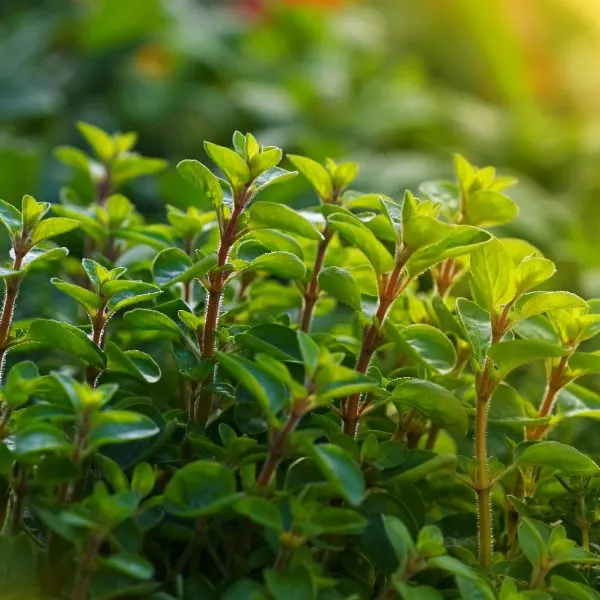
Oregano is a woody perennial plant that belongs to the mint family Lamiaceae. It is a herbaceous flowering plant, which means that it is an aromatic plant with a strong odor and it produces flowers by which it reproduces.
Its flowers may be pink, pinkish purple, purple, or white. They are an attractive addition to your garden and they enrich the appearance of the flowers of Echinacea.
Oregano can bring useful insects to the garden through its flowers and keep pests away through its strong scent.
Regarding growth needs and requirements, both plants have similarities. They both are drought-resistant when established and suffer stress in soggy soil.
Oregano prefers full sun but Echinacea is flexible, thriving in both full sun and shade.
If you intend to grow them together, plant them in a sunny spot for the best results. Hummingbirds, green lacewings, and ladybugs are some beneficial animals that the flowers of oregano attract.
They are all great pollinators for your plants.
Hummingbirds eat flies, ants, aphids, mites, beetles, weevils, and mosquitoes. The larvae of lacewings are ferocious predators of aphids. Ladybugs feed on aphids, mealybugs, thrips, maggots, mites, beetles, and whiteflies.
In addition to attracting animals that prey on pests and help with pollination, oregano itself can repel such insects as flies and mosquitoes.
It serves as a very good companion plant for Echinacea.
20. Pepper Plants

Pepper plants are flowering plants of the nightshade family Solanaceae, like eggplants and tomatoes.
There are several species and cultivars of pepper plants existing. They produce peppers of various colors like red, yellow, orange, and green.
Their flowers are usually white or purple in color. Together with Echinacea flowers, the flowers of pepper plants are able to attract pollinators to themselves.
They also attract pest predators like parasitoid flies and predatory wasps.
Plants like pepper which are in the nightshade family usually have deep taproots and are heavy feeders. Because they require more nutrients (and nitrogen) than most other plants, they should be paired with light feeders.
Echinacea is a light feeder and so it would not be threatened by the presence of a heavy feeder near it.
Another beneficial companionship for plants that use up plenty of soil nutrients is nitrogen-fixing plants like legumes.
Legumes make up for the lost nutrients but they are not needed in this instance because pepper’s heavy feeding is balanced by Echinacea’s light feeding.
They both grow well in similar conditions.
Like coneflowers, peppers do not tolerate overly moist soil and would prefer drier soil for good health.
Because peppers like full sun and Echinacea can grow well under both full sun and partial shade, plant them in a sunny area of the garden.
While their flowers attract pollinators like bees and butterflies, pepper plants themselves are quite effective at pest control.
They deter ants, aphids, cabbage worms, caterpillars, deer, mealybugs, mites, rabbits, sawflies, scales, and squirrels.
21. Rosemary
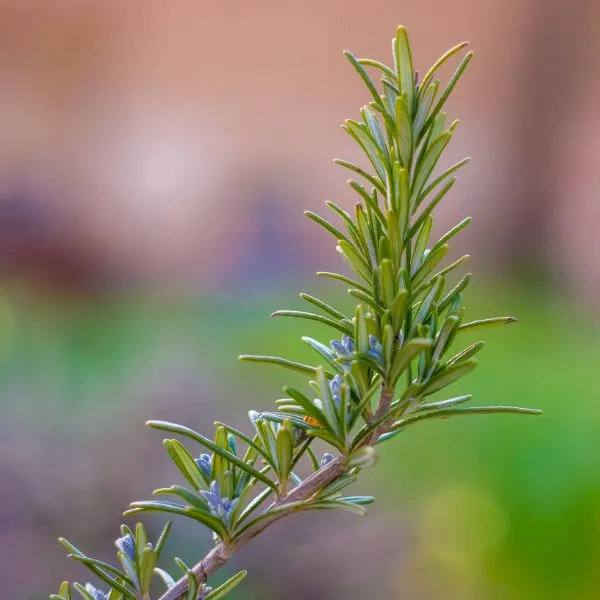
This woody perennial flowering plant belongs to the mint family Lamiaceae.
The aromatic herb has thin, fragrant, evergreen, and needle-like leaves. Owing to the oil it yields, it is fragrant and grown for use in both medicine and cooking.
Rosemary likes to grow in conditions similar to those that coneflowers enjoy. They both do not like soggy soil so they prefer slightly moist, well-drained soil and they thrive in direct sunlight or partial shade.
The tiny, beautiful flowers that rosemary produces when in bloom come in different colors including blue, pink, purple, and white.
They can attract pollinators to your garden, including different kinds of bees and butterflies.
Some types of bees that the flowers of rosemary attract are bumble bees, honey bees, mason bees, and mining bees. Some other flies that feed on nectar are also brought to the area and they help with pollination.
Because of its woody scent, rosemary is also able to keep several pests from attacking your Echinacea and other crops.
It is a deterrent to cabbage moths, carrot flies, mosquitoes, and several other kinds of flies.
This makes rosemary suitable as a companion for Echinacea when it is planted with some other good companions that are attractive to common pests. Because it is an aromatic plant, it can help control some crop pests.
22. Sage
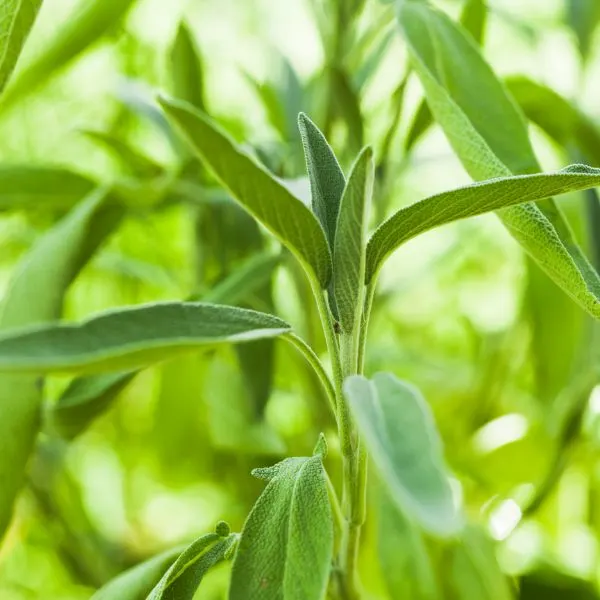
Sage is another perennial flowering plant in Lamiaceae, the mint family.
This aromatic herb has woody stems, stunning blue to purple flowers, and distinct greyish-green leaves. It is grown mostly for use as a culinary spice or a medicinal herb.
This herb can attract pollinators with its flowers while keeping pests away with its scent.
Sage is also easy to grow and grows comfortably near Echinacea. It will thrive whether planted under full sun or in partial shade.
It however appreciates direct sunlight more, so consider that when planting this pair. Moist, well-drained soil that is neutral or slightly acidic is preferred.
Both plants are drought tolerant so it is better to water them less than risk overwatering.
When in bloom, sage attracts pollinators, including butterflies, hummingbirds, and bees. As a natural pest control herb, it is also able to repel beetles, cabbage moths, carrot flies, flea beetles, snails, and Echinacea’s worst pest: aphids.
23. Stachys
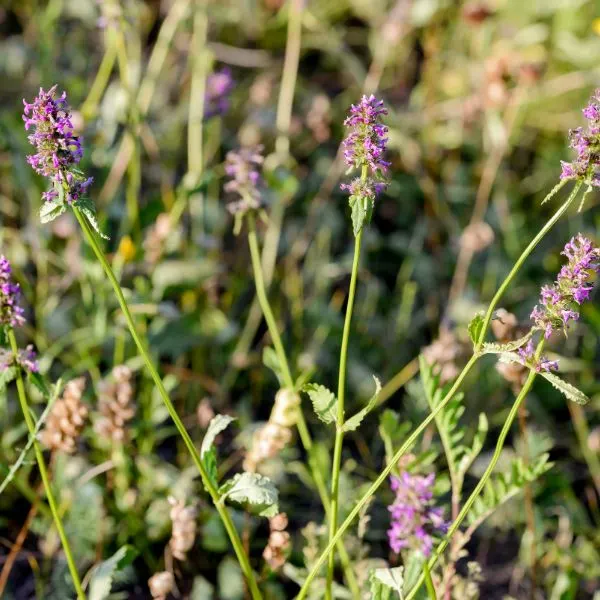
More commonly known as hedge nettles, plants in the very large genus Stachys are flowering plants which belong to the family Lamiaceae.
About 300 to 450 species are estimated to be known currently in this genus.
Stachys grows well in moist but well-draining soil. It does not appreciate excessive watering or soggy soil but it does need constant, even, and moderate amounts of moisture.
It is quite drought resistant and grows well in full sun or partial shade.
Hedgenettles bear flowers when in bloom which may be red, purple, pink, white, or yellow.
These attract pollinators to Echinacea and other flowering plants that you might have in your garden to aid their reproductive process.
The flowers can bring several types of bees, butterflies, and even hummingbirds into the area.
They are also able to attract hoverflies which help control the infestation of aphids, thrips, and whiteflies.
24. Stonecrop
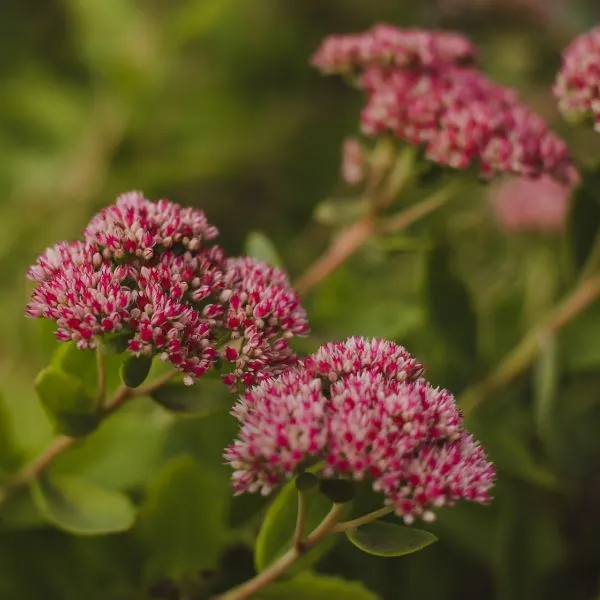
Stonecrop is any flowering plant in the large genus Sedum.
This genus belongs to the family Crassulaceae which is also known as the stonecrop or orpine family. Members of this genus are about 400 to 500 species in number.
Most species have peachy pink flowers again bluish-green leaves and rose-red stems. Stonecrops are very aesthetically pleasing plants that would attract the attention of pollinators.
With another flowering plant beside them, they are beneficial.
Similar to its companion, stonecrop would grow fairly equally well both under direct exposure to sunlight and under partial shade.
It needs very little water for its growth, meaning that it is also a drought-tolerant plant.
There are stonecrop hybrids with rose, pink and white flowers but all are very beautiful to pollinators. They may bring butterflies, hoverflies, hummingbirds, and parasitoid wasps around the area they are planted in.
Although this plant attracts aphids, caterpillars, and whiteflies, the beneficial insects that it attracts, some of which also serve as pollinators, help control these pests. The larvae of parasitoid wasps and hoverflies especially prey on aphids.
25. Yarrow
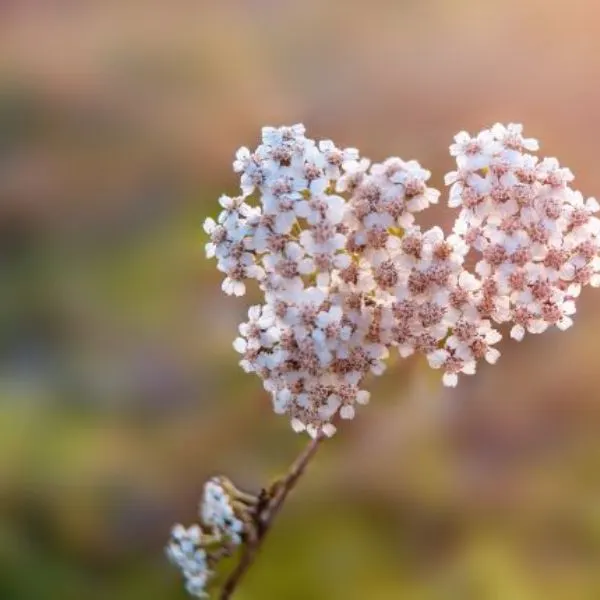
Also known as old man’s pepper, sanguinary, devil’s nettle, soldier’s woundwort, or common yarrow, yarrow is a flowering herb in the aster or daisy family Asteraceae.
It has a sweet scent and its flowers may be white, yellow, pink, or red.
Yarrow is a wildflower that grows best in full sun and moist, well-draining soil. It is a drought-resistant plant that prefers to be underwatered rather than overwatered.
If placed under full or partial shade, it tends to grow long and straggly.
So when planting yarrow with Echinacea, make sure to place them in an area with adequate sunlight. This way, you can get the best results. Yarrow can attract beneficial insects to aid both pollination and the control of pests.
The absolutely stunning flowers of yarrow come in different colors including soft pastel and brilliant shades of white, gold, orange, red and yellow. They are very attractive to beneficial insects and are useful to the other plants around the yarrow.
Pollinators like bees and butterflies will likely come to the area on account of the plant. Pest predators such as green lacewings, hoverflies, lady beetles, and parasitoid wasps will come as well.
All the insects above help control aphids which Echinacea is easily susceptible to.
Hoverflies also feed on whiteflies and thrips. Parasitoid wasps and their larvae prey on whiteflies and caterpillars too.
26. Salvia
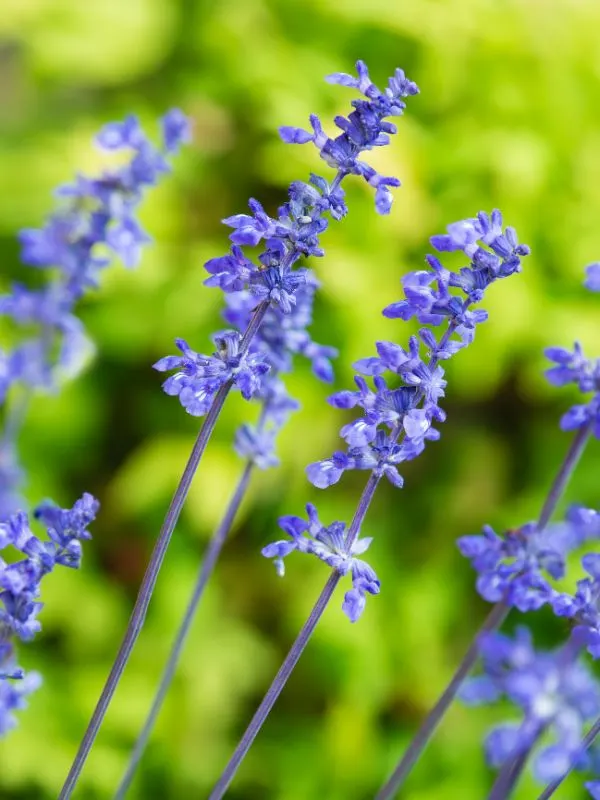
The fascinating Salvia farinacea species of salvia, often known as blue sage and mealy cup sage, belongs to the mint family. One of the several genera that are frequently referred to as sage. Other species either have leaves with distinctive scents or are utilized in cooking.
They shield the young coneflowers from predators and dehydration, and their strong aroma frequently deters coneflower pests like aphids and mealybugs.
When planted with Echinacea, these deep blue perennials provide a dramatic border. Likewise, they need similar growing conditions as coneflowers. Salvia’s rich violet blossoms, which draw butterflies, are another advantage.
27. Ornamental Grasses
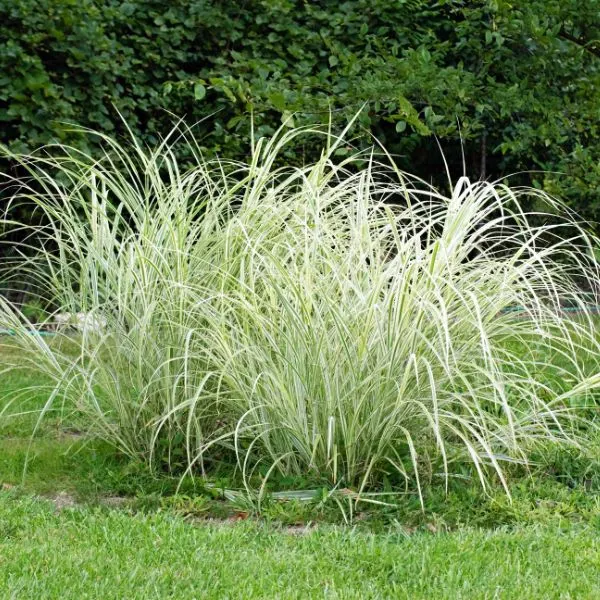
The term “ornamental grasses” refers to numerous distinct groups of grass-like plants. Sedges (Cyperaceae), rushes (Juncaceae), restios (Restionaceae), and cattails are some of them (Typhaceae).
The majority of ornamental grasses are herbaceous perennials; however, some possess woody tissues, and many are evergreen.
Echinacea grows nicely with ornamental grasses that prefer sunny, draining soil. There are many different types to pick from, and many of them frequently produce beautiful inflorescences to add extra interest to the landscape. Their movement and elegance are the ideal complements to the coneflowers’ brilliant splendor.
28. Globe Thistle
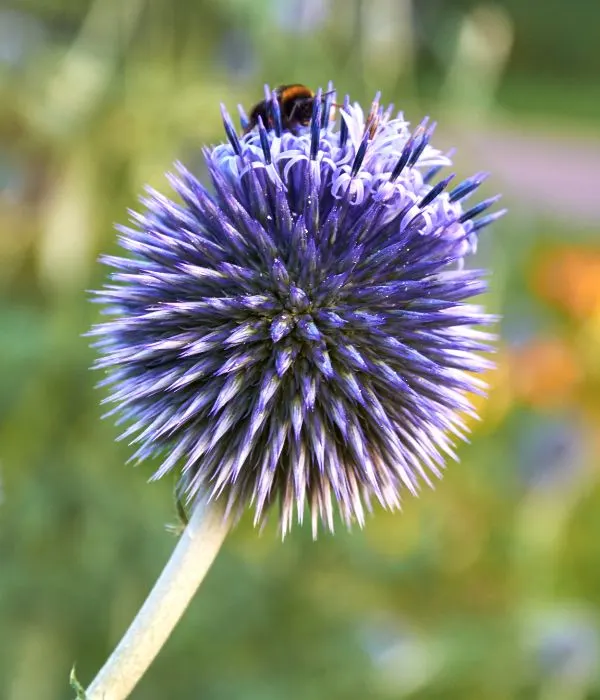
Echinops, commonly known as globe thistles, is a genus of flowering plants in the family Asteraceae; for hundreds of years, globe thistle has been consumed as a supplement to help in lactation and reduction of inflammation.
Globe thistle is another perennial herb that goes well with coneflowers. It can also be grown with other flowers as a companion plant! It can also survive in bright sunlight or some light shade.
In addition to adding beauty to your gardens, it also draws pollinators to the coneflowers, boosting the overall pollinator activity there.
29. Chrysanthemums
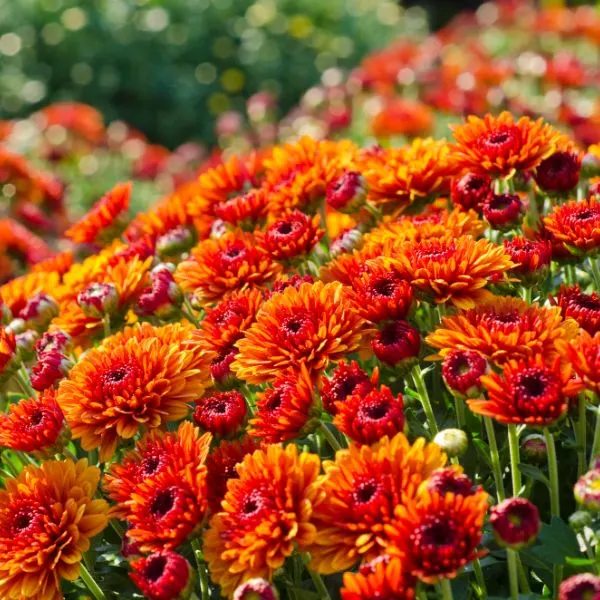
Chrysanthemums are blooming plants of the genus Chrysanthemum in the family Asteraceae, sometimes known as mums or chrysanths. Chrysanthemum leaves are used as greens, especially in Chinese cuisine, and come in colors other than traditional yellow, such as white, purple, and red.
Any flower arrangement would benefit from the addition of chrysanthemums. When mixed with other types of flowers, such as coneflowers, they provide a great appearance.
Coneflowers gain a lot from the presence of chrysanthemums since they are easy to grow and require little upkeep, allowing you to use them throughout the whole growing season. Their flowers survive far longer and produce wonderful cut flowers, unlike the majority of your other blossoms.
30. Blue Phlox
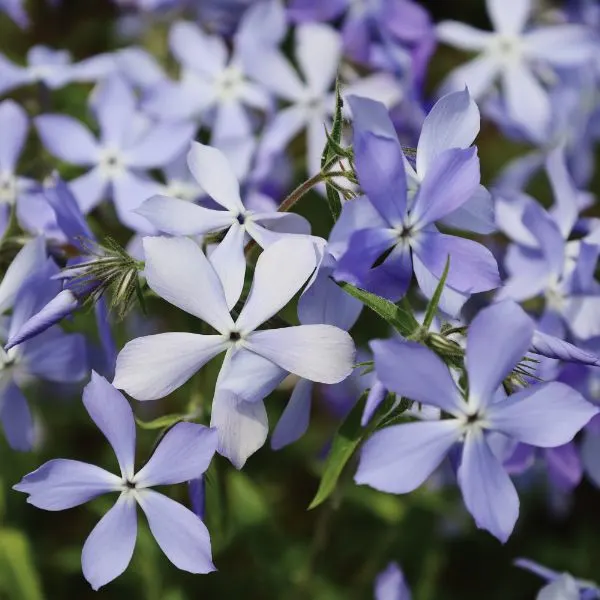
The wild blue phlox, also known as woodland phlox or wild sweet william, is a species of flowering plant in the Polemoniaceae family. The petals come in a range of pastel colors, including blue-lavender, light purple, pink, and white. It was used as an eye wash, a stimulant, and on wounds, bruises, and burns.
Blue Phlox bloom in the yard with magnificent petals that wonderfully complement the Echinacea blooms. Although, They should preferably be planted as a border in front of your garden of coneflowers.
Additionally, since blue phlox is a cross-pollinated plant, coneflowers draw butterflies, hummingbirds, and other pollinators to the plant. This increases pollinator activity in your garden, which is excellent for completing blue phlox pollination.
31. Blazing Star Liatris
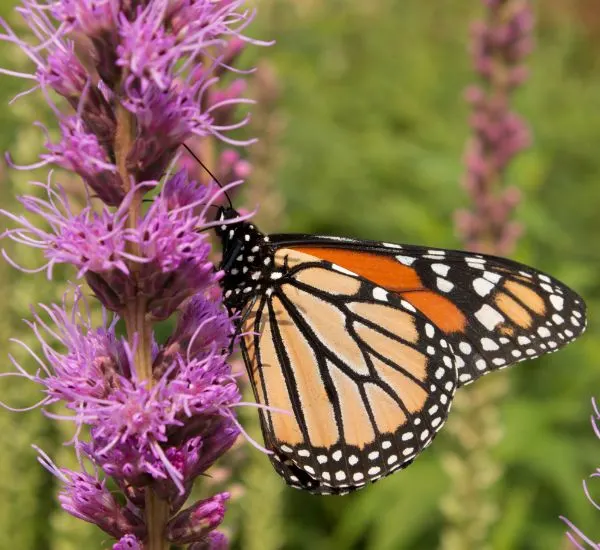
Liatris also referred to as Blazing star and gayfeather, is a genus of flowering plants in the Eupatorieae of the family Asteraceae. Native Americans once used Liatris spicata as a medicine.
Coneflowers thrive in flower gardens because of their nectar and pollen-rich flowers, which draw a variety of butterflies and hummingbirds.
Additionally, dried Liatris adds beauty to other dried flower bouquets in your garden.
32. Beard Tongues
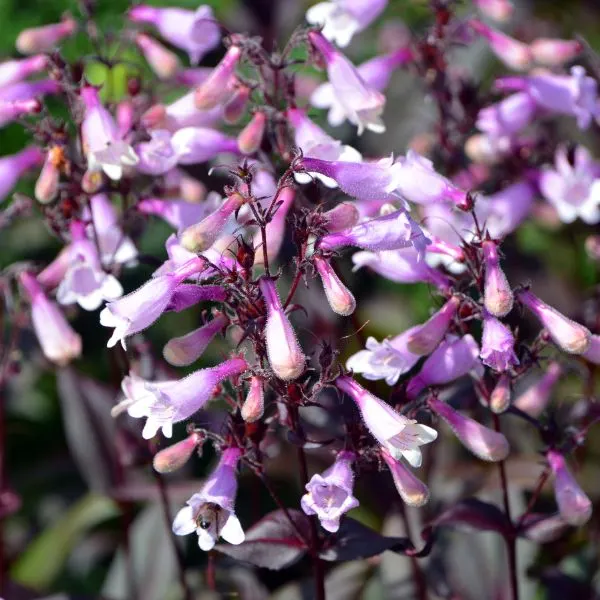
Penstemon, also known as beard tongues, is a large plant genus that contains about 250 species of flowering plants. They were occasionally used as both human and animal medicines. But today, they are mainly used for ornamental purposes.
They are One of those ‘whole package’ native plants; Hairy Beardtongue can draw hummingbirds, butterflies, and bees to the garden. Additionally, coneflowers make an excellent ground cover plant for Beard’s tongue. Both are complemented by one another by the garden’s brilliant colors.
This plant flourishes when planted close to other blooming plants like coneflowers because of its ability to produce seeds. And In turn, because it is a deer-resistant flower, it aids in preventing deer from consuming immature coneflowers, which are particularly vulnerable to deer attacks.
33. Bachelor buttons

Centaurea cyanus, sometimes called cornflower or bachelor’s button, is an Asteraceae family annual flowering plant. Depending on the variety, Centaurea cyanus flowers can be consumed raw, dried, or cooked.
Their Dried petals are often used in seasonings, and their primary function is to give food coloring. And they are in varieties of colors which include blue, white, purple, pink, or even black petals.
Once Planted, they typically survive droughts and are resistant to deer. And This makes the bees more attracted to bachelor buttons. This also makes Pollinators easily available throughout spring when nectar is scarce because they start flowering in the spring when pollen and nectar are so scarce.
34. Baby’s Breath
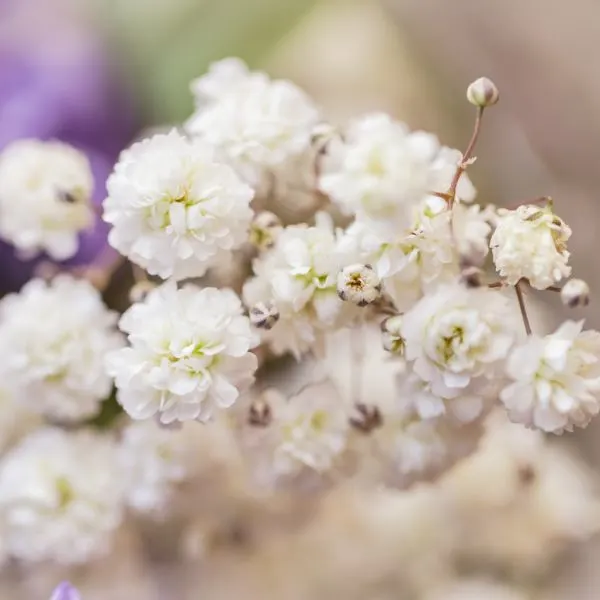
Gypsophila, sometimes referred to as baby’s breath is a genus of flowering plants in the Caryophyllaceae family of carnations. Baby’s breath is frequently utilized in floral arrangements like bouquets. They are also grown commercially for food, herbal medicine, and floristry.
Coneflowers contrast well with baby’s breath, which also draws pollinators. They look fantastic both in the garden and in a vase of cut flowers. It also aids in enhancing soil quality By delivering nutrients to the earth and giving the coneflowers additional nutrients,
It frequently serves as a filler flower when coneflowers or other flowers with vivid colors are present. Additionally, it makes a fantastic ground cover for flower beds.
35. Aster

The genus Aster belongs to the family Asteraceae and includes Flowering perennial plants. Aster variants are common garden plants because of their lovely, alluring, and colorful blooms. Additionally, they come in a variety of colors, such as white, red, pink, orange, and purple.
Aster is a perennial that attracts pollinators and blooms in the late summer when most other flowers have faded. This makes it irresistible for pollinators during the late summer and also enhances the color of your coneflower garden.
Asters are a particular favorite of birds and butterflies in the autumn, which makes them an excellent companion plant for Coneflower since it attracts more pollinators during that period.
36. Basket flower

The basketflower, also known as the American starthistle, is a native of the southern and central United States as well as northeastern Mexico. This annual plant is frequently grown for its colorful blossoms.
The American Basket Flower complements the vibrant and colorful view of the Coneflowers with its showy Flowers, and it is ideal for the back of flower borders or meadow plantings in your garden. The American Basket Flower’s flowers also draw butterflies and other bees, increasing the density of pollinators in your garden. This makes it an exceptional companion for Coneflowers.
Bad Companion Plants for Echinacea
In general, there are not many bad companion plants for Echinacea; plants in this genus simply do not need to be near other crops that would attract more aphids to them, especially if such plants do not also attract predators to control them.
Listed below are some plants that are very attractive to these pests and they are briefly explained. If you want to or have already planted any of the ten (10) crops listed below, grow good companions that repel pests nearby or transplant them.
1. Apples
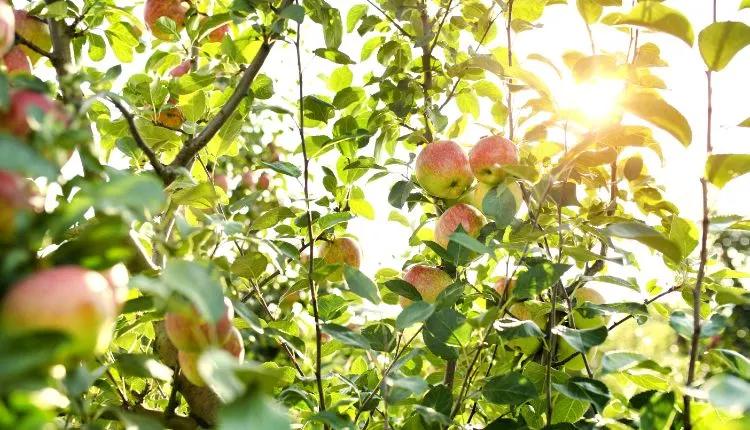
Apple trees are the most widely cultivated species in their genus Malus. They are bred for their edible fruits, apples.
There are several cultivars of apples existing, with over 7,500 currently known.
The different cultivars are grown for numerous reasons for raw consumption, cooking, and the production of cider. Apple trees have beautiful, usually white flowers. Their fruits are susceptible to infestation from many pests and diseases.
2. Berries

Berries are small, pulpy fruits that are usually edible and consumed by humans and other animals as food.
They are typically juicy, rounded, and brightly colored in appearance. As for their taste, they are sweet, sour, or tart.
Examples of berries include blackberries, blackcurrants, blueberries, raspberries, strawberries, and white currants. This is however not the botanical definition of a berry.
Berries attract and are attacked by various insects, such as aphids, codling moths, curculio, cutworms, Japanese beetles, leafhoppers, mites, and spider mites.
Because Echinacea is not able to fend its pests off, it should be kept away from berries.
3. Cherries
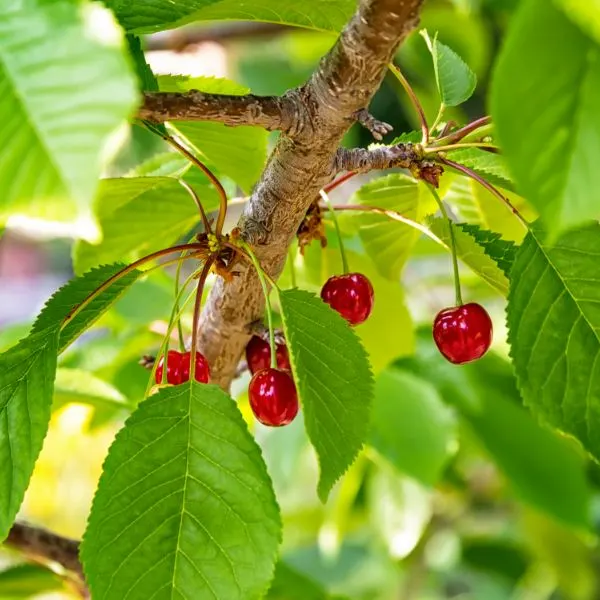
A cherry is the stone fruit (called a drupe) of any of the species of flowering plants, which grow into trees, in the genus known as Prunus.
Prunus belongs to the rose family Rosaceae and consists of other fruits like nectarines, peaches, and plums.
Cherries are susceptible to the infestation of aphids, fruit flies, Japanese beetles, leaf miners, slugs, and several other insects. To avoid spreading these, do not plant them near Echinacea but with plants that can help control these pests.
4. Marigolds
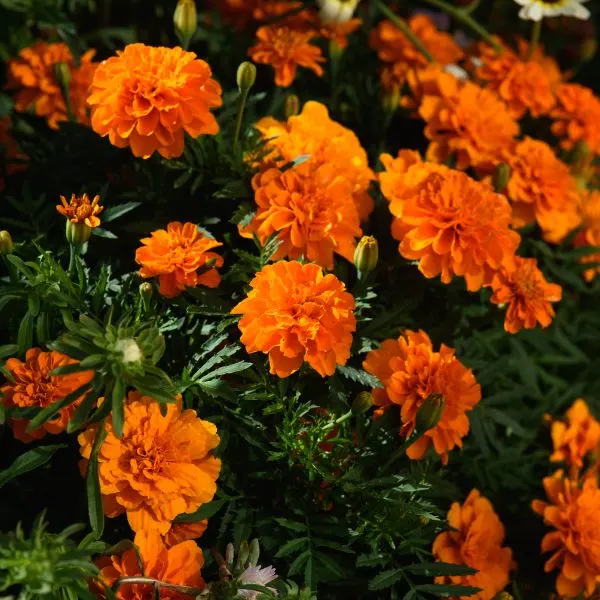
A marigold is any species of herbaceous flowering plant in the genus Tagetes of the aster family Asteraceae. The plant has green, pinnate leaves and brightly colored flowers.
Its very beautiful flowers may be yellow, white, orange or golden.
These flowers attract beneficial insects like hoverflies, ladybeetles, minute pirate bugs, and parasitoid wasps.
The joint efforts of these pest predators help control the spread of aphids, caterpillars, thrips, and whiteflies.
Growing marigolds and Echinacea together is not a great idea simply because leafhoppers and aphids are attracted to them both. Because the insects it attracts can control aphids, it might be worth a shot to grow marigolds near coneflowers.
5. Nasturtiums
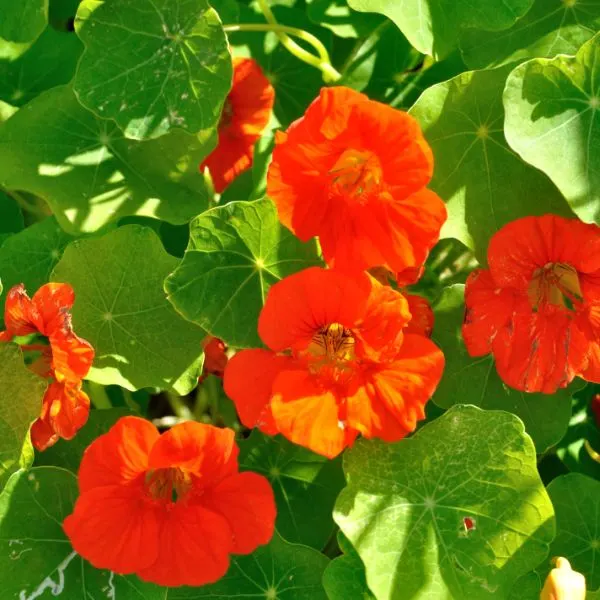
Also known as Tropaeolum, nasturtium is a genus of plants that contains several creeping herbaceous plants which may be annual or perennial.
These plants have showy round flowers and may be used in herbal medicine or cooking.
Nasturtiums are also attacked by many pests. Some are aphids, caterpillars, flea beetles, leaf miners, leafhoppers, mealybugs, slugs, snails, and spider mites. Grow them away from your Echinacea plants.
6. Peaches
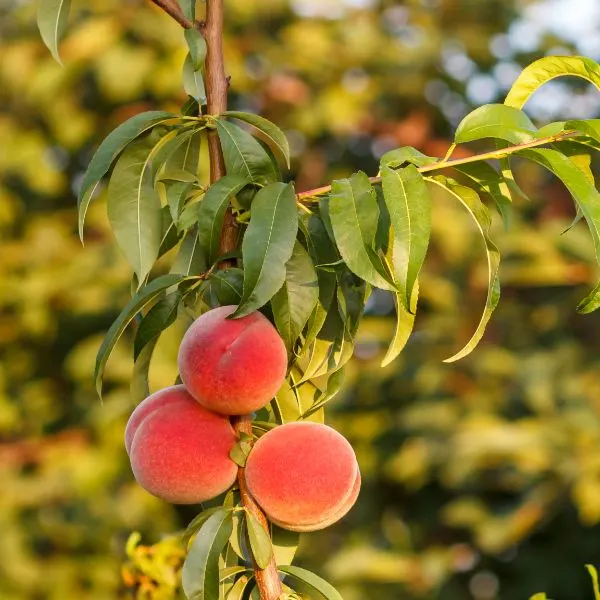
Peaches are the juicy, edible fruits of the deciduous peach tree. This tree bears flowers and is a member of the genus Prunus in the biological family Rosaceae (the rose family).
So many pests like to feed on peaches.
Examples are fruit moths, curculios, wood-boring beetles, scales, spider mites, thrips, codling moths, earwigs, aphids, and Japanese beetles. Some of these also attack Echinacea so planting them together will attract the pests even more.
7. Plums
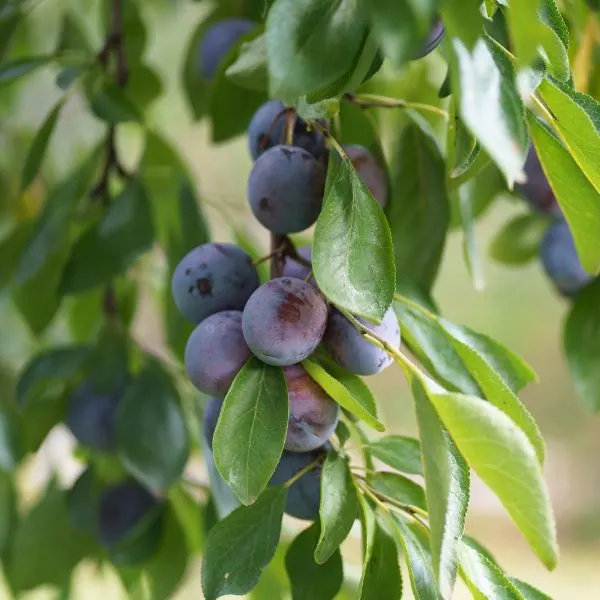
Plums are the edible fruits of some flowering plant species in the genus Prunus of the rose family Rosaceae. Plum trees do not help Echinacea solve its pest problems; they instead bring more pests into the area.
Although aphids are attracted to almost any crop, plums also draw codling moths, maggots, sawflies, Japanese beetles, thrips, curculios, scales, spider mites, and other insect pests to themselves.
8. Roses
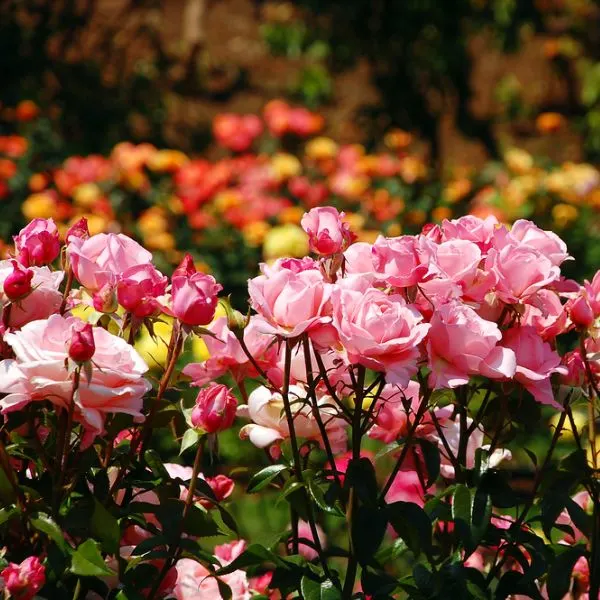
Roses are biennial or short-lived perennial plants. They are woody flowering plants in the family Rosaceae.
They have distinct flowers which are popular for ornamentation and different species or cultivars have peculiar colors.
The pests of these plants are also very many, including slugs, mites, aphids, whiteflies, weevils, leafhoppers, beetles, thrips, sawflies, leaf cutters, and scales. It will benefit the Echinacea plants in your garden if they are kept away from roses.
9. Sunflowers
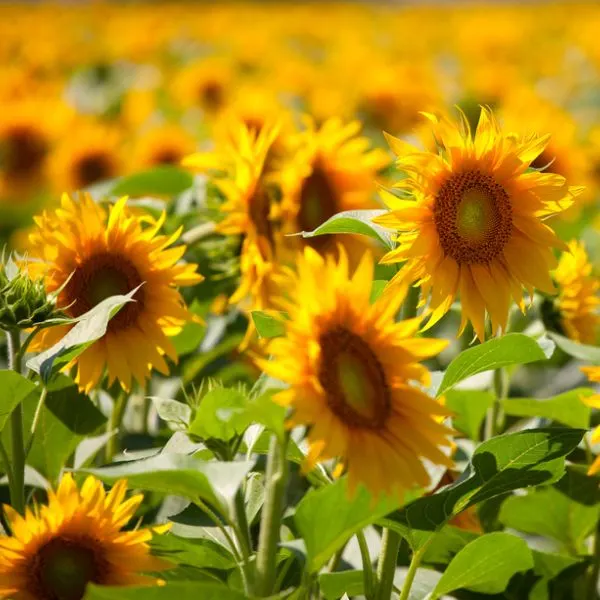
A sunflower is any species of annual and perennial plants that belong to the genus Helianthus in the family Asteraceae, the daisy family.
They bear flowers that have large heads, dark disk florets, and flamboyant yellow rays.
Sunflowers are susceptible to attacks from aphids, beetles, caterpillars, curculios, cutworms, moths, thrips, and several kinds of weevils. Instead of with Echinacea, plant sunflowers with other crops that can help control pest infestation.
10. Tomatoes

A tomato plant is a South American plant of the nightshade family Solanaceae. It produces a widely grown mildly acidic edible fruit also known as tomato, with many varieties in red or yellow color.
It is pulpy and may be eaten raw or cooked.
Like eggplants and pepper plants, tomato plants have deep taproots and are heavy feeders. Although coneflowers strike a balance by being light feeders, companionship between the two will not be beneficial.
Tomatoes get attacked by aphids, cutworms, flea beetles, fruit worms, hornworms, potato beetles, nematodes, spider mites, tobacco budworms, and whiteflies. Plant your tomatoes elsewhere with plants that can help protect them from pests.
11. Yarrow
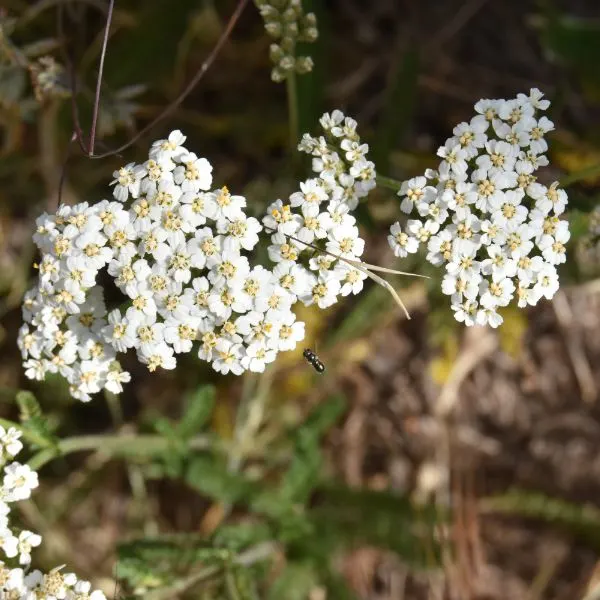
One of the flowers that can be readily overpowered by the vigorous growth patterns of wild yarrow is the Coneflower or Echinacea. Coneflowers may lose out to yarrow in the race for sunshine, which could result in fewer pollinator visits (and stunted growth for your Echinacea).
While the yarrow is not a good companion to the Coneflower, it is tempting to plant lavender and yarrow with coneflowers since the nutritional and pollination advantages are not easily overlooked.
FAQs
What grows well next to Echinacea?
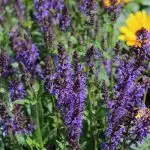
Some crops that grow well next to Echinacea plants include bee balm, black-eyed Susan, blanket flowers, brassicas, butterfly weed, cardinal flowers, catmint, chamomile, chives, coral bells, coreopsis, eggplants, geraniums, lavender, onions, oregano, pepper plants, rosemary, sage, Stachys, stonecrop, and yarrow.
Can you plant Echinacea with other plants?
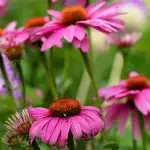
Yes, you can grow Echinacea with other plants. Twenty-five (25) examples of such good companion plants are listed and explained above.
What flowers go well with coneflowers?
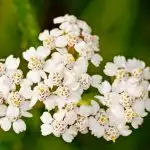
Some flowers that go well with coneflowers include bee balm, black-eyed Susan, blanket flowers, butterfly weed, cardinal flowers, coral bells, coreopsis, geraniums, stachys, stonecrop and yarrow.
How far apart should Echinacea be planted?
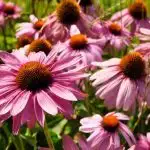
Leave about 18 inches between Echinacea and other plants in your garden. About 6 to 12 inches may be left between the coneflowers themselves.
Does Echinacea attract mosquitoes?

No, Echinacea does not attract mosquitoes. Instead, these plants produce an essential oil that repels mosquitoes.
What kind of plant is Echinacea?
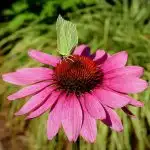
Echinacea is a tough perennial that can withstand harsh winters.
They complement other late perennials and grasses nicely since they flower in the late summer, especially in prairie-style landscapes.
Can Echinacea be grown in pots?
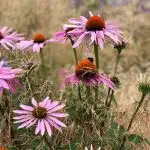
As long as they have enough space to grow, lovely Echinacea flourishes in both garden borders and containers. They should be planted in a deep container that is placed in an area with lots of sunshine.
Where should coneflowers be planted for the greatest results?
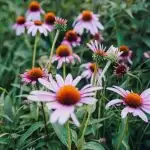
Coneflowers prefer soil that drains well and directs sunlight. Although coneflowers may thrive in a variety of soil types, nutrient-rich soil is where they bloom at their finest.
What distinguishes Echinacea from Coneflower?

One of the three distinct genera referred to as coneflowers are Echinacea. Echinacea Angustifolia and Echinacea purpurea are two well-known members of the Echinacea genus. Purple coneflowers, or (more ambiguously) plain coneflowers, is the popular name for members of the Echinacea species.
Should I plant coneflowers in groups?
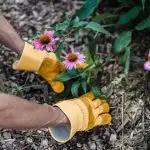
Coneflowers should be planted in clusters of the same color, not randomly, and in a variety of hues. For instance, plant pink-purple Magnus coneflowers (Echinacea purpurea ‘Magnus’), which have orange accents on the center tips, are close to white-flowered Fragrant Angel coneflowers (Echinacea purpurea ‘Fragrant Angel’).
How can coneflowers be made bushy?
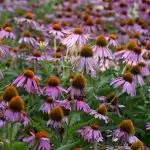
The best time to prune your Echinacea plants is in the spring if you want to achieve a generally bushy appearance. Your beauty’s blooming season will be extended by this procedure, which will ensure healthy growth. These plants can also have all of their dead blooms removed to allow a place for new ones to bloom.
What Coneflower has the longest blooming period?
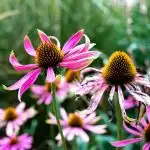
Blossoming flowers that begin in late spring and last through mid-fall (or until the first frost in some climates).
How many coneflowers should i plant together?
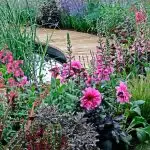
It’s difficult to say exactly how many coneflowers you should plant together since it will vary depending on the space you have and then of course the size of the actual plants.
There should be enough space for them to get adequate sunlight as a rule of thumb.
Can I plant Echinacea in my vegetable garden?
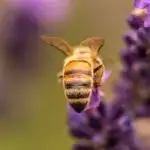
Yes, you can plant Echinacea, also known as coneflower, in your vegetable garden. It’s a beneficial flower to have because it attracts bees and butterflies which are important for pollination.
Conclusion
Listed and explained above are twenty-five (25) good companion plants and ten (11) bad companion plants for Echinacea.
Keep in mind that your plants will tolerate most plants; it only does not need more pest activity near them.
Coneflowers, species in the genus Echinacea, grow well in both full sun and partially or lightly shaded areas. They need soil that is able to hold water fairly well but drains properly too and has a neutral to slightly acidic pH.
When they are established in the soil and begin to grow leaves, these plants become drought-tolerant.
In their earlier stages, however, keep them consistently, evenly, and fairly moist. Do not overwater them; underwatering is ideal.
Most flowers, herbs, and vegetables in the garden can be planted alongside Echinacea.
Plants in this genus have in them certain active substances that boost the function of the immune system and improve resistance to infections.
Other benefits include pain relief, reduction of inflammation, antioxidant effects, and relief from such illnesses as acne, boils, allergies, bites, stings, sores, cough, aches, flu, sore throat, mild asthma, tonsillitis, and fungal infections.
Incorporating companion planting strategies with echinacea not only enriches the garden’s biodiversity but also leverages the medicinal properties of plants like echinacea pallida and e. purpurea. Whether in rock gardens, wildflower gardens, or a perennial flower garden, these companion plants offer a great way to extend the bloom time and ensure the vitality of your garden for a long time, well into the late winter and beyond.
Check out more types of things:
